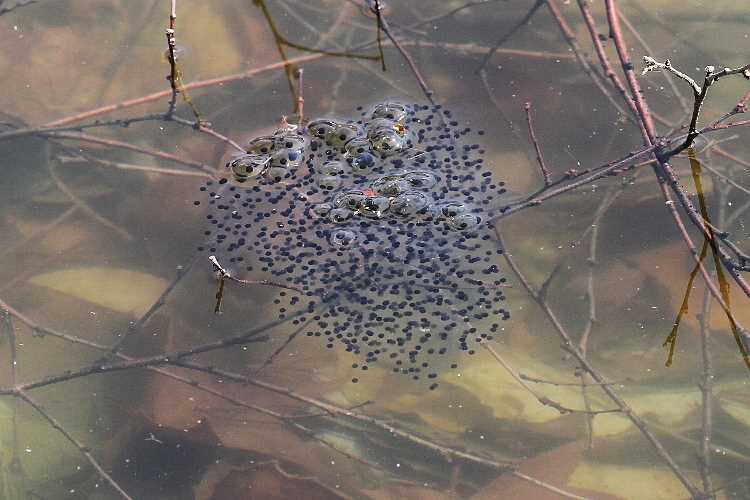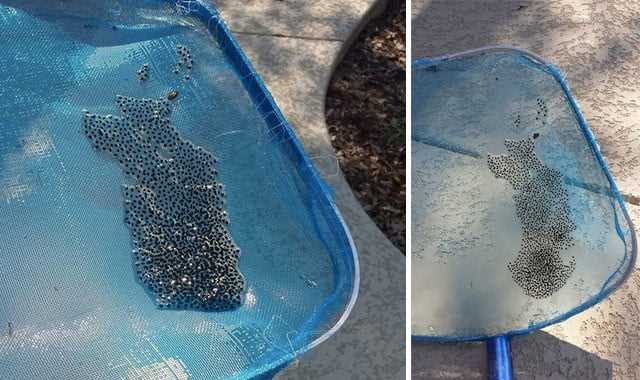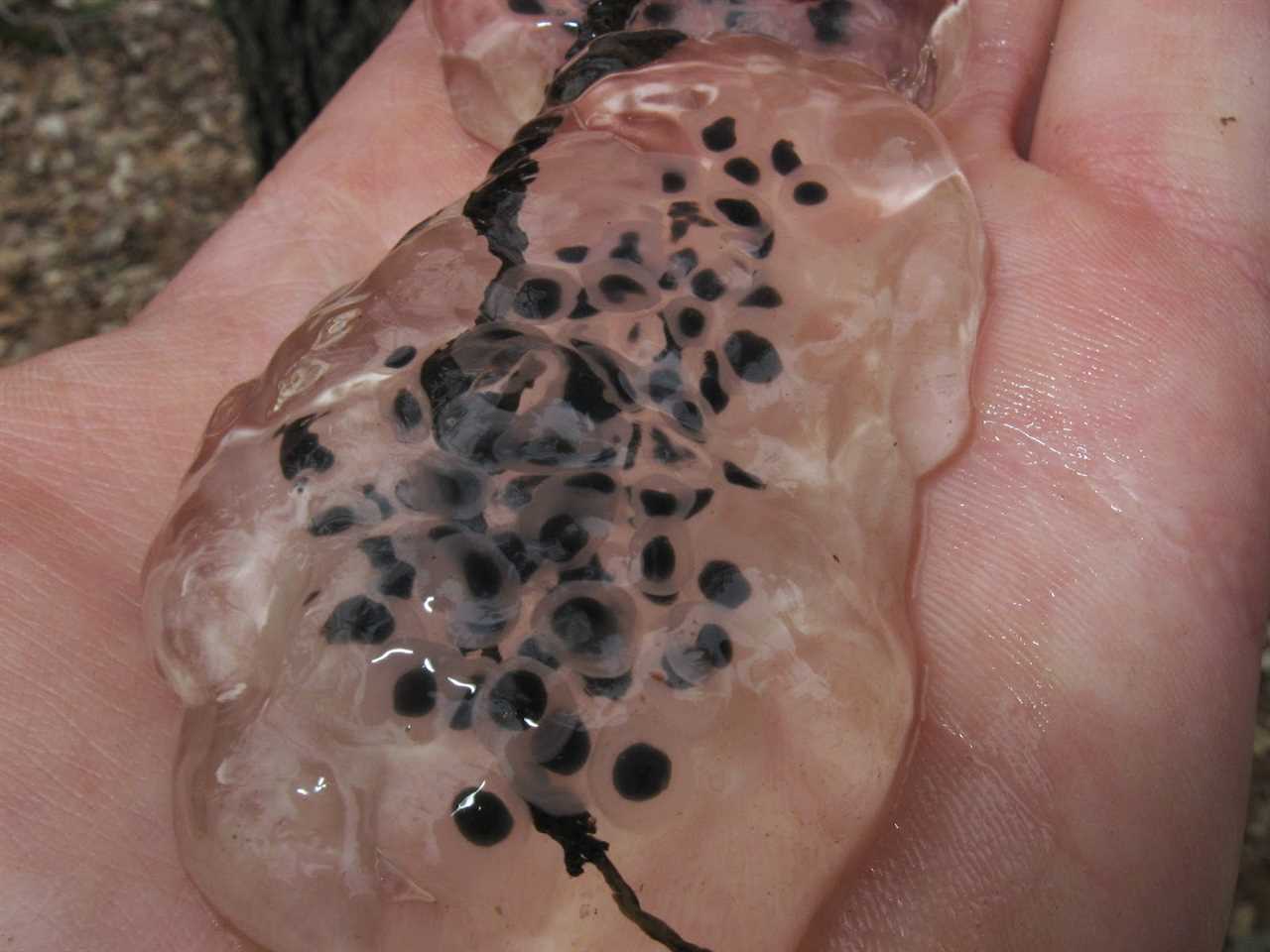
What do these eggs actually look like? Well, picture a small gelatinous mass filled with tiny black dots. These dots are actually fertilized eggs that will later develop into tadpoles. The gelatinous mass serves as a protective barrier, keeping the eggs safe from predators and environmental factors.
In addition to their functional purpose, frog eggs are truly a sight to behold. The way the black dots are arranged in the transparent jelly creates a visually striking pattern. When the sunlight hits the pool and shines through the eggs, it illuminates their beauty and adds a touch of magic to the whole scene.
The Intriguing Life Cycle of Frog Eggs
When you take a look at a pool filled with frog eggs, you might wonder what these strange, jelly-like blobs actually are. Well, those jelly-like blobs are the eggs of frogs. Frog eggs are fascinating structures that play a vital role in the reproduction and life cycle of these amphibians.
What Do Frog Eggs Look Like?


Frog eggs typically look like transparent jelly balls or small clusters of rounded cells. They are usually laid in water, whether it’s a quiet pond, a marsh, or a backyard pool. The gelatinous coating surrounding the eggs provides protection and moisture. These eggs are usually found in large masses, often attached to aquatic plants or floating freely in the water.
Depending on the species, frog eggs can vary in size, shape, and color. Some frog eggs are small and resemble tiny commas, while others are larger and rounder. Colors can range from clear to milky-white, and some species may have pigmented eggs with shades of black, brown, or green.
What Do Frog Eggs Do?
After a female frog lays her eggs in water, they go through a process called external fertilization. This means that the eggs are fertilized by the male’s sperm outside of the female’s body. Once fertilized, the eggs develop and grow into tadpoles.
The gelatinous coating of the eggs provides moisture and protection against drying out. It also acts as a barrier to some predators, preventing them from accessing the developing embryos inside. Additionally, the jelly-like mass helps to anchor the eggs to plants, which keeps them in place and prevents them from being swept away by water currents.
Frog eggs are incredibly important for the survival of the frog species. They represent the beginning of the frog’s life cycle and are essential for species reproduction. Without eggs, there would be no tadpoles, no metamorphosis, and no adult frogs.
So, the next time you come across a pool filled with frog eggs, take a closer look and appreciate the intricate process and beauty of frog reproduction. These tiny jelly-like blobs hold the potential to transform into fascinating creatures, showcasing the wonders of the natural world.
The Remarkable World of Frog Reproduction
What Do Frog Eggs Look Like?
Frog eggs come in various shapes and sizes, depending on the species. They are usually round or oval-shaped, with a gelatinous outer layer that protects the developing embryo. The outer layer, called the jelly capsule, provides buoyancy and shields the eggs from predators and harsh environmental conditions.
One of the distinguishing features of frog eggs is the presence of a black spot at the center of each egg. This spot is called the blastopore and is where the frog’s anus will form later in its development. The blastopore is also the site where fertilization takes place.
The Process of Frog Reproduction
The journey of frog reproduction begins with the male frog attracting a female through a series of calls or unique mating rituals. Once the female is ready to lay her eggs, she releases them into a suitable pool or water body.
The male frog then fertilizes the eggs by releasing his sperm over the clutch, and the sperm and eggs meet at the blastopore. After fertilization, the jelly-like outer layer acts as a protective barrier, preventing the eggs from drying out and ensuring their survival.
The Importance of Frog Eggs in Pools
Frog eggs play a crucial role in maintaining the delicate balance of ecosystems. They serve as a food source for predators like insects and fish, contributing to the overall biodiversity of the environment. Additionally, the tadpoles that hatch from the eggs help control mosquito populations by feeding on their larvae.
The Remarkable Transformation of Frogspawn
When we think of frogs, we often envision their unique ability to transform from a tiny egg into a hopping amphibian. This miraculous process begins with the formation of frogspawn, the jelly-like mass that can be found in pools and bodies of water.
What Do Frog Eggs Look Like?
As we peer into a pool filled with frogspawn, we are greeted with a mesmerizing sight. The eggs, which resemble small black dots, are suspended within the gelatinous mass. Although they can vary in size and shape depending on the frog species, they generally have a spherical or oval appearance.
What makes frog eggs truly fascinating is their ability to absorb water and expand in size. This expansion, combined with the gelatinous coating, helps protect the eggs against dehydration and harmful external conditions. It’s incredible to think that these tiny black dots will eventually develop into tadpoles and then full-grown frogs.
The Journey from Egg to Tadpole
The transformation of frogspawn into tadpoles is a captivating process. After a period of incubation, typically lasting a few weeks, the eggs begin to hatch. The tiny tadpoles emerge, wiggling their way out of the protective gelatinous mass.
This remarkable journey from egg to tadpole to frog is a testament to the adaptability and resilience of these incredible creatures.
Witness the Mesmerizing Journey from Egg to Tadpole
But what do these eggs actually do? When a female frog lays her eggs in a pool of water, they provide a safe environment for the embryos to develop. The jelly-like substance surrounding the eggs acts as a protective barrier, shielding them from predators and providing a constant supply of moisture. This moisture is essential for the development of the eggs and ensures they do not dry out.
But what exactly is a tadpole? A tadpole is the larval stage of a frog’s life cycle. It resembles a tiny fish, with a long tail and no limbs. Tadpoles rely on their gills to breathe in the water and feed on algae and other small plants. They spend their days swimming around, exploring their aquatic world, and growing rapidly.
As time passes, the tadpoles continue to grow and develop. Eventually, they will start to develop limbs, lose their tails, and undergo a process called metamorphosis. This is when the tadpole transforms into a fully formed frog. The entire journey from egg to tadpole to frog is truly mesmerizing to witness.
So, the next time you come across a pool of frog eggs, take a moment to appreciate the incredible journey these tiny embryos are embarking on. From their mesmerizing appearance to their transformation into tadpoles and eventually frogs, frog eggs are truly remarkable. They provide us with a glimpse into the mysterious and enchanting world of frog reproduction, and remind us of the wonders of nature.
What do frog eggs in a pool look like?
When you stumble upon a pool filled with frog eggs, you are in for a visually stunning sight. The appearance of frog eggs can differ depending on the species, but they generally share some common characteristics.
Secondly, frog eggs are often grouped together in clusters or masses. This helps protect the eggs and increase their chances of survival. These clusters can range in size from small pea-sized formations to larger masses that cover the surface of the water. The arrangement of the eggs can create a captivating pattern, almost like a natural work of art.
Thirdly, the texture of frog eggs is jelly-like or gelatinous. This consistency helps to keep the eggs moist and protects them from drying out. It also provides a cushioning effect, safeguarding the delicate embryos within. When you touch a frog egg, you may find it slightly slimy or slippery to the touch.
Lastly, the color of frog eggs can vary. Some species lay eggs that are clear, while others have a greenish or brownish tint. These colors blend in with the surrounding environment, making it harder for predators to spot the eggs.
- Translucent or transparent appearance
- Grouped together in clusters or masses
- Jelly-like or gelatinous texture
- Varying colors, from clear to greenish or brownish
Overall, the sight of frog eggs in a pool is a truly remarkable one. Their unique appearance and characteristics not only fascinate us but also play a vital role in the survival and reproduction of these incredible creatures.
Uncovering the Ecological Significance of Frog Eggs in Pools
In addition to their unique appearance, frog eggs serve several important ecological functions within pool ecosystems. Firstly, they provide a vital food source for many aquatic organisms. Insects, small fish, and even other amphibians feed on the nutritious eggs, contributing to the overall food chain in the pool.
Interestingly, frog eggs in pools can also act as temporary habitats for various aquatic organisms. Algae, bacteria, and small invertebrates often attach themselves to the gelatinous mass, creating a microcosm of biodiversity. This microhabitat provides shelter and protection for these organisms, contributing to the overall biodiversity of the pool ecosystem.

I’m Lena Adams—a product of an unconventional upbringing in the African wilderness. My father, a daring explorer of African wildlife, sparked my fascination with reptiles, a passion that intertwined with the tragic loss of my mother during an expedition, leaving an indelible mark on my life. Driven to understand the creatures that captivated my parents, I embarked on my journey, sharing insights about reptiles, frogs, and lizards on my website. Through my explorations and conservation efforts, I honour my family’s legacy while seeking connections—to the creatures, nature, and the mother whose presence I yearn to understand.
